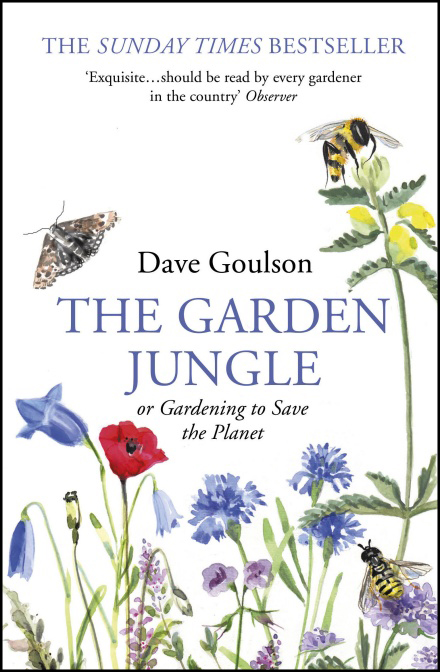A review of The Garden Jungle: or Gardening to Save the Planet by Dave Goulson.
Over the course of my 20 years of work in conservation and education, I have learned that people generally want to do the right thing, but find it hard to break through the noise to discover what that might mean or how to do it. The “noise” I refer to is often information and products that don’t really make things better, and only drive sales and profits—greenwashing, in other words. Nevertheless, the human desire to do the right thing is an opportunity for those of us working in conservation, and one we should be working together to leverage.
.jpg)
The Garden Jungle or Gardening to Save the Planet is globally relevant and reaffirmed the work that I do every day—to further conservation and make the world more sustainable for us, while remaining habitable for the creatures that are so essential for the beauty we see around us. (Photo: Xerces Society / Cameron Newell)
Xerces began this effort in our conservation niche nearly 10 years ago with the publication of Attracting Native Pollinators. This practical how-to guide has since found its way into the homes of thousands of people across the country, likely transforming the way many of them garden. While pollinators are incredibly important to maintain a balance in natural and urban areas, as well as the successful harvests on farms, they are just the tip of the invertebrate iceberg—in terms of diversity and helping the world function—countless other creatures call our gardens and green spaces home (or at least used to).

So, what can we do to help them? Surely, much of what is suggested in Attracting Native Pollinators will improve the situation, but if you want to take a deeper dive, I suggest a new book by Dave Goulson: The Garden Jungle: or Gardening to Save the Planet.
I’ve been a big fan of Dr. Goulson’s writing for a long time. He has written important scientific treatises like Bumblebees: Behaviour, Ecology, and Conservation, which helped to shape my understanding of bumble bees and informed my conservation work since its publication in 2010.
More recently, he has written a series of natural history books in the vein of Bernd Heinrich: A Buzz in the Meadow, A Sting in the Tale, and Bee Quest. These three books have something for everyone—written in a style that is informative, humorous and hopeful (yet realistic). As such, I was expecting The Garden Jungle to be a great read, but for me it was more than that. While at times focused on the United Kingdom, it is globally relevant and reaffirmed the work that I do every day—to further conservation and make the world more sustainable for us, while remaining habitable for the creatures that are so essential for the beauty we see around us.
Dr. Goulson takes us through why and how to create a garden that works for so many of these creatures, while also maintaining the beauty and function for which we have been using our gardens for millenia (food, connection to nature, serenity). He begins by discussing the complexity of gardens and plant selection, and then, chapter by chapter, introduces us to many of the creatures you will meet in your backyard—along with practical ideas to help create a space for them, and the systems they support. You’ll learn a new appreciation for earwigs (voracious predators of garden pests, not human brains), worms (world’s best composters?), moths (perhaps we should call them night-time butterflies?), ants (herders, farmers), and compost!
.jpg)
In Dave Goulson's book The Garden Jungle or Gardening to Save the Planet, you’ll learn a new appreciation for earwigs (voracious predators of garden pests, not human brains), worms (world’s best composters?), moths (perhaps we should call them night-time butterflies?), ants (herders, farmers), and compost! (Photo: Xerces Society / Stephanie McKnight)
Mixed in with all of this is perhaps one of the most sobering chapters I’ve ever read, about how pesticides have altered the health of ourselves and our planet. It is worth buying the book solely for this chapter—though it is not easy to read. Notably, Dr. Goulson cites a study done in 2016 in Germany that found 99% of humans tested had glyphosate (most commonly used active ingredient for killing weeds) in their urine. Glyphosate is used heavily in non-organic wheat production, so it’s no surprise that most of us have the chemical flowing through our veins. I won’t steal Dr. Goulson’s thunder, but much more (and more concerning) information lies within. This chapter, “The Toxic Cocktail,” lays the foundation for the work that lies in front of us: We must work together to make our yards, parks, neighborhoods, communities, cities, and societies less dependent on chemical inputs. That work starts at home, with the decisions we make each day.
The best way to reduce our need for chemical inputs is to recreate the ecological systems that ran the planet before we disturbed it. This book does not provide a template for solving problems at a global scale, but starting small will build a community and movement around these principles—gardens should be functional by providing bountiful food and beauty and by supporting the wildlife to which our lives are inextricably linked. If we all practice the principles outlined in this practical and humbling book, we will have taken a dramatic and meaningful step forward—and into The Garden Jungle.
Further Reading
Check out the rest of our Earth Week content!




